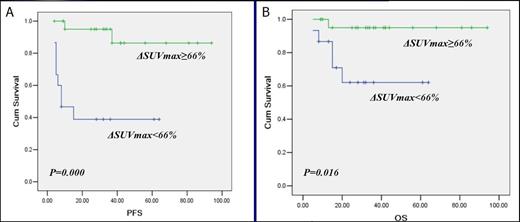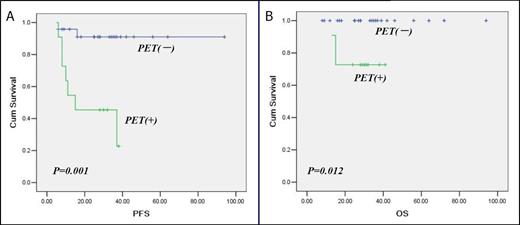Abstract
Taking a step forward from the international prognostic index, attention is focused on the role of 18F-fluorodeoxyglucose positron-emission tomography-Computed Tomography scan (PET) as a tool for guidance in risk stratification in patients with diffuse large B-cell lymphoma (DLBCL). Here, we analyzed the predictive value of interim and post-treatment PET in patients with DLBCL.
In our retrospective study, we analyzed a homogeneous cohort of newly diagnosed DLBCL patients treated with R-CHOP21 who underwent PET scan at diagnosis, after three cycles of chemotherapy and at the end of treatment. For interim PET, images were interpreted by computing maximum standardized uptake value between PET performed at baseline and after three cycles of immuno-chemotherapy (¦¤SUVmax). The images of post-treatment PET were interpreted visually according to the International Harmonization Project criteria. The primary study endpoints were progression-free survival (PFS) and overall survival (OS).
Thirty-eight patients with DLBCL with PET data were identified. The median follow-up was 28 months. At interim PET evaluation, optimal cutoff to predict progression was 66% for ¦¤SUVmax. ¦¤SUVmax analysis (≥66% vs< 66%) identified patients with significantly different 2-year PFS (90.7% vs 38.9%; P =.000) and 2-year OS (95.5% vs 62%; P=.016) (Fig1). Post-treatment PET status (negative vs positive) was statistically significantly associated with 2-year PFS (91% vs 45.5%; P =.001) and 2-year OS (100% vs 72.7%; P =.012) (Fig2).
Two-year Kaplan-Meier estimates of (A) progression-free survival and (B) overall survival according to interim positron emission tomography (PET) using ¦¤SUVmax for DLBCL patients.
Two-year Kaplan-Meier estimates of (A) progression-free survival and (B) overall survival according to interim positron emission tomography (PET) using ¦¤SUVmax for DLBCL patients.
Two-year Kaplan-Meier estimates of (A) progression-free survival and (B) overall survival according to interim positron emission tomography (PET) using ¦¤SUVmax for DLBCL patients.
Two-year Kaplan-Meier estimates of (A) progression-free survival and (B) overall survival according to interim positron emission tomography (PET) using ¦¤SUVmax for DLBCL patients.
These data support the prognostic utility of PET in interim and post-treatment settings in patients with DLBCL treated with R-CHOP21. An interim PET scan after three cycles of treatment can effectively predict the outcome by using quantitative assessment of ¦¤SUVmax and allows clinicians to design a risk-adapted therapeutic strategy. A positive PET after the completion of therapy identifies a patient subset with an inferior PFS and OS.
No relevant conflicts of interest to declare.
Author notes
Asterisk with author names denotes non-ASH members.



This feature is available to Subscribers Only
Sign In or Create an Account Close Modal